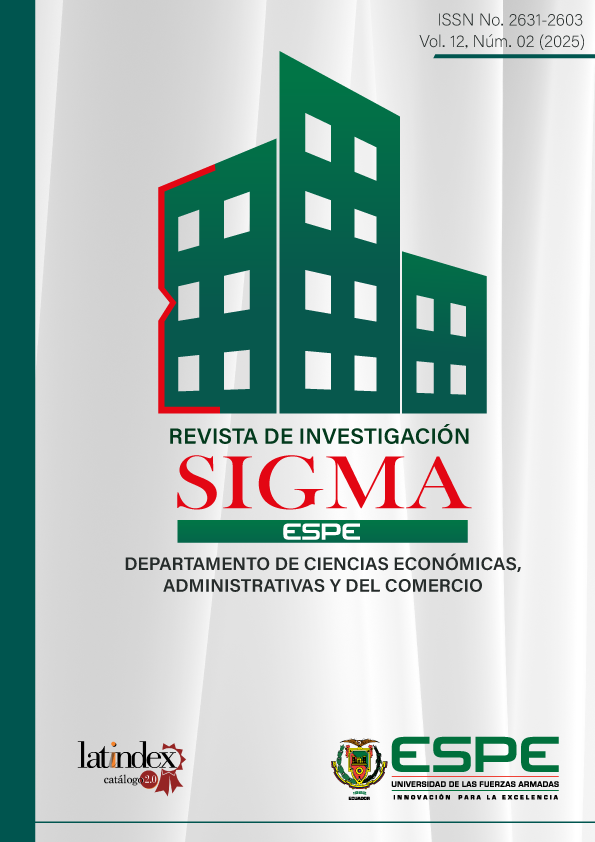Estructura de Capital y Costo de Financiamiento en las Cooperativas de Ahorro y Crédito del Ecuador
Main Article Content
Abstract
El artículo analiza cómo la estructura de financiamiento incide en el costo promedio ponderado de capital (WACC) de las cooperativas de ahorro y crédito (COAC) del Ecuador. El propósito es estimar y comparar el WACC entre los segmentos 1, 2 y 3 y evaluar su relación con la mezcla de pasivos y patrimonio. Se utilizaron datos anuales 2015–2024 de la Superintendencia de Economía Popular y Solidaria (SEPS); el costo de la deuda (Kd) se aproximó con Intereses causados dividido para el Pasivo con costo y el costo del capital propio (Ke) se construyó con un esquema build‑up: Ke = rf + EMBI + RP_coop. Se calcularon dos definiciones: WACC total‑weight (ponderación Pasivos/Activos) y WACC cost‑weight (ponderación Pasivo con costo/Activos). La metodología siguió un enfoque cuantitativo, con estadística descriptiva por segmento‑año y modelos lineales con efectos fijos de año y errores agrupados por entidad. El principal hallazgo muestra WACC medianos 2015–2024 cercanos a 7,4–7,6% en segmentos 1–2 y 8,1–8,5% en segmento 3, con niveles próximos a 9–10% en 2024. El tamaño se asoció negativamente con el WACC; los coeficientes de participación de pasivo con costo y patrimonio mantuvieron signo esperado, sin significancia robusta. Se concluye que la incidencia de la estructura de financiamiento sobre el WACC se materializa principalmente a través de economías de escala y del costo efectivo de los pasivos con costo, con diferencias moderadas entre segmentos.
Palabras Clave: Estructura de Capital, Costo de Financiamiento, Segmentos, Cooperativas de ahorro y crédito. Sistema Financiero.
Abstract
This article analyzes how the financing structure affects the weighted average cost of capital (WACC) of savings and credit cooperatives (COACs) in Ecuador. The purpose is to estimate and compare the WACC between segments 1, 2, and 3 and evaluate its relationship with the mix of liabilities and equity. Annual data from the Superintendency of Popular and Solidarity Economy (SEPS) for the period 2015–2024 were used; the cost of debt (Kd) was approximated with accrued interest divided by liabilities with cost, and the cost of equity (Ke) was constructed using a build-up approach: Ke = rf + EMBI + RP_coop. Two definitions were calculated: total-weight WACC (Liabilities/Assets weighting) and cost-weight WACC (Liabilities with cost/Assets weighting). The methodology followed a quantitative approach, with descriptive statistics by segment-year and linear models with year fixed effects and errors clustered by entity. The main finding shows median WACCs for 2015–2024 close to 7.4–7.6% in segments 1–2 and 8.1–8.5% in segment 3, with levels close to 9–10% in 2024. Size was negatively associated with the WACC; the ratios of liabilities with cost and equity maintained the expected sign, without robust significance. It is concluded that the impact of the financing structure on the WACC is primarily realized through economies of scale and the effective cost of liabilities with cost, with moderate differences between segments.
Keywords: Capital Structure, Cost of Financing, Segments, Savings and Credit Cooperatives, Financial System.
Article Details

This work is licensed under a Creative Commons Attribution-NonCommercial-ShareAlike 4.0 International License.
- Los autores/as conservan los derechos de autor y conceden el derecho de la primera publicación a la revista, con el trabajo registrado con la licencia de atribución de Creative Commons, que permite a terceros utilizar lo publicado siempre que mencionen la autoría del trabajo y a la primera publicación en esta revista.

